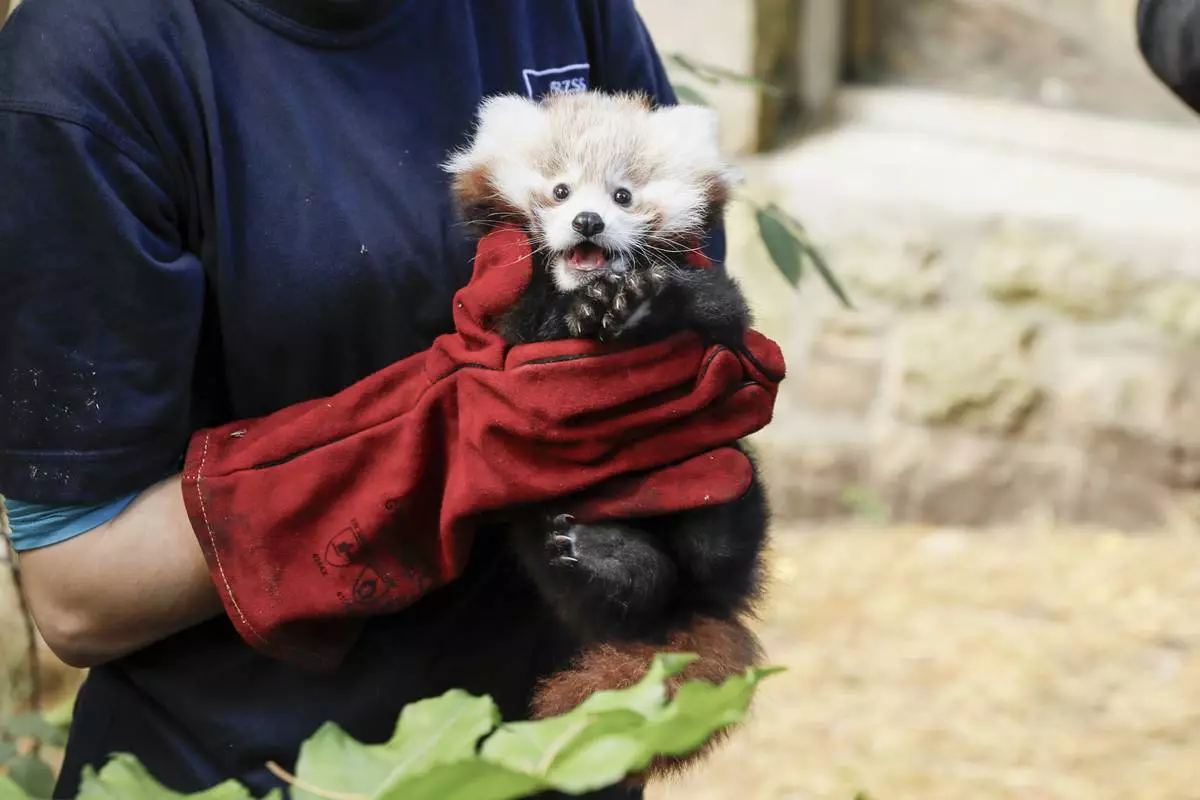LONDON (AP) — Zookeepers in Scotland have blamed pyrotechnics from annual Bonfire Night celebrations for the death of a baby red panda named Roxie.
The three-month-old died on Nov. 5 after choking on vomit that was believed to be caused by stress from the explosions that could be heard to mark Guy Fawkes Day, when fireworks and bonfires are lit to mark the failed plot in 1605 to blow up the British Parliament.
“Roxie had access to her den, but the frightening noises seem to have been too much for her," said Ben Supple, deputy chief executive of the Royal Zoological Society of Scotland, which owns Edinburgh Zoo. “Very sadly, she choked on her vomit on Bonfire Night and our vets believe this was probably a reaction to fireworks."
The red panda, a cat-sized nocturnal animal with reddish fur and a shaggy tail, is native to the eastern Himalayas and southwestern China.
While it is protected in India, Bhutan, China, Nepal and Myanmar, the species is threatened by habitat loss, human encroachment and poaching. Fewer than 10,000 remain in the wild.
The small mammals have a low chance of survival — even when born in captivity — and they are especially vulnerable in their first months. Studies show that as many as 60% don't reach their first birthday, according to the Toronto Zoo, which in August announced the death of one of two infant red pandas born there in June.
Roxie's mother, Ginger, died five days earlier but Roxie had been eating on her own and responding well to care, Supple said. Stress from fireworks in the days between Halloween on Oct. 31 and Guy Fawkes' Day could have been a contributing factor in the mother's death, he said.
Pet owners are well aware of the distress fireworks can cause dogs, cats, horses and other animals.
The Royal Society for the Prevention of Cruelty to Animals has campaigned for tighter restrictions and the zoo used the incident to call for a ban on fireworks sales and for only light, public pyrotechnic displays.
A petition to curb fireworks was signed by more than 1 million people and delivered to British Prime Minister Keir Starmer's office this month.
Police in Edinburgh said disorder on Bonfire Night had caused a state of alarm in the city this year. More than a dozen people have been arrested so far on allegations that include shooting fireworks at police officers and other anti-social behavior.
Scottish community safety minister Siobhian Brown said this had been the first year that local authorities could ban the use of fireworks in certain areas. She said it was now a matter for the U.K. government to take up.
Alex Cole-Hamilton, leader of the Liberal Democrats in the Scottish Parliament, said current rules don't seem to be working and there may need to be a ban on noisy fireworks.
“This is extremely sad news. These are rare and beautiful creatures," said Cole-Hamilton. “The scenes across Edinburgh over the last few weeks have been anarchic and troubling."

This photo provided by Royal Zoological Society of Scotland on Thursday, Nov. 14, 2024 shows red panda Roxie as zookeepers in Scotland have blamed pyrotechnics from annual Bonfire Night celebrations for the death of the baby red panda. (Royal Zoological Society of Scotland via AP)
An An and Ke Ke, recently gifted to Hong Kong by the central government, met members of the public for the first time on December 8.

Vital expertise: Ocean Park Zoological Operations Assistant Curator Elke Wu says experts from the China Conservation & Research Centre for the Giant Panda have given the care team invaluable assistance. Source from news.gov.hk
Under the dedicated care provided at Ocean Park, the two lively giant pandas are adjusting well to their new environment, and have been eating and sleeping well.
The park is providing specialist training for the pandas, to make it easier for caregivers to perform dental and blood pressure checks, draw blood samples, and even undertake ultrasound examinations, without the need for anaesthesia.
Ocean Park Zoological Operations Assistant Curator Mandy Tang explained that adult giant pandas are large and powerful, and that their bite force is very strong. This means health checks must be performed with care inside their dedicated training cages.
"By just calling [a panda's] name, if he is willing to come close and allow you to hand-feed him, this is already a basic part of his caregiving training."
An An has already learned to walk from the exhibition area to his training cage on hearing Mandy's call. On arriving in the cage, he extends his hand and makes a fist.
The caregivers have carried out what they call “desensitisation” training with An An. This allows them to use a trimmer on his fur, apply disinfectant to his skin, and gently apply a syringe to his arm, without him becoming frightened. As a reward for accepting their care without fuss, he is given apple slices.
"Giant pandas are very smart,” Mandy stressed. “Step by step, we teach him to touch a target stick with his nose. With the help of the target stick, we can lead him from one place to another, and he can even lie down for us to measure his body temperature.”.

Meal preparation: The giant pandas’ diet includes bamboo, bamboo shoots, vegetables, high-fibre cookies and freshly steamed "wo wo tou". Source from news.gov.hk
Nutritious diet
Giant pandas eat four meals a day. Their staple food is bamboo from Sichuan and Guangzhou.
The caregivers store the bamboo in a food cabinet that is temperature-controlled and has a sprinkler system to keep the plants fresh.
"The supply and taste of bamboo is greatly affected by weather and environmental factors such as water and soil,” Mandy said. “We provide each giant panda with five to six different types of bamboo daily."
Their diet also includes bamboo shoots, fruit, vegetables, and high-fibre cookies. Like humans, individual pandas have different preferences. While An An loves apples and carrots, "wo wo tou" is Ke Ke's favourite.
"Wo wo tou is freshly made by us from rice flour, soybean flour, and cornmeal, mixed with eggs,” Mandy explained. “The ingredients are kneaded like bread dough, and then steamed."
Giant pandas in the wild spend a lot of time looking for food. Accordingly, Ocean Park has enriched the pandas' environment with items they can play with and which allow them to “forage” even in a captive environment where there is sufficient food.
"We want them to use their intelligence, and their sense of taste, smell, and sight, to forage, which is good for their mental health."
Both five years old – roughly equivalent to 15 years old for a human – An An and Ke Ke have entered what is considered to be adulthood for giant pandas. Mandy highlighted that spring is the breeding season for the species, and said the park will closely monitor any behavioural changes.
"For instance, we will observe whether Ke Ke rubs her tail on the ground. Giant pandas have glandular secretions in their tails, leaving behind a unique scent, which is an important sign of entering their mating season."

Mental stimulation: “Environmental enrichment” items such as this ball allow the pandas to simulate the process of foraging for food in a captive environment. Source from news.gov.hk
Future attractions
The first panda twin cubs born in Hong Kong are anticipated to be another huge attraction at Ocean Park.
Currently about four months old, the twins' canine teeth are now becoming visible.
Ocean Park Zoological Operations Assistant Curator Elke Wu said pandas feel itchy in their mouths and often want to chew on things at the teething stage.
"When they reach seven to eight months old, they will begin to pick up leftover bamboo leaves or other solid food from their mother and learn to chew. We will then let them try softer foods like bamboo shoot granules."
She added that with the twins' forelimbs growing strong, they can now support themselves to crawl forward, meaning that they will probably soon learn to stand up and walk.

Close monitoring: Ocean Park Zoological Operations Assistant Curator Mandy Tang says she will observe any behavioural changes in Ke Ke during the breeding season. Source from news.gov.hk
Expert guidance
Elke has been working at Ocean Park for 17 years and has cared for older giant pandas such as the late An An and Jia Jia, as well as Le Le, Ying Ying – the twins' mother – and now her precious offspring.
She said that she was honoured to have experts from the China Conservation & Research Centre for the Giant Panda assisting the Ocean Park team with delivery and rearing, and stressed that their experience in panda care has been vital.
"From the beginning, we all followed the teachings of the experts. In the first few days after Ying Ying's labour, we were reluctant to leave because the experience was so valuable. From choosing the delivery room and the facilities in the nursery to the amount of milk fed to the cubs, we heavily relied on the experts' invaluable experience."
She added with a smile that while most mother pandas like to eat honey, Ying Ying is not a big fan. With the help of the experts, however, the team discovered that she is fond of electrolyte water, which turned out to be useful in getting her to eat and aided in her postpartum care.

Desensitisation process: Caregivers gently touch An An’s arm with a syringe to familiarise him with the blood-drawing process. Source from news.gov.hk















